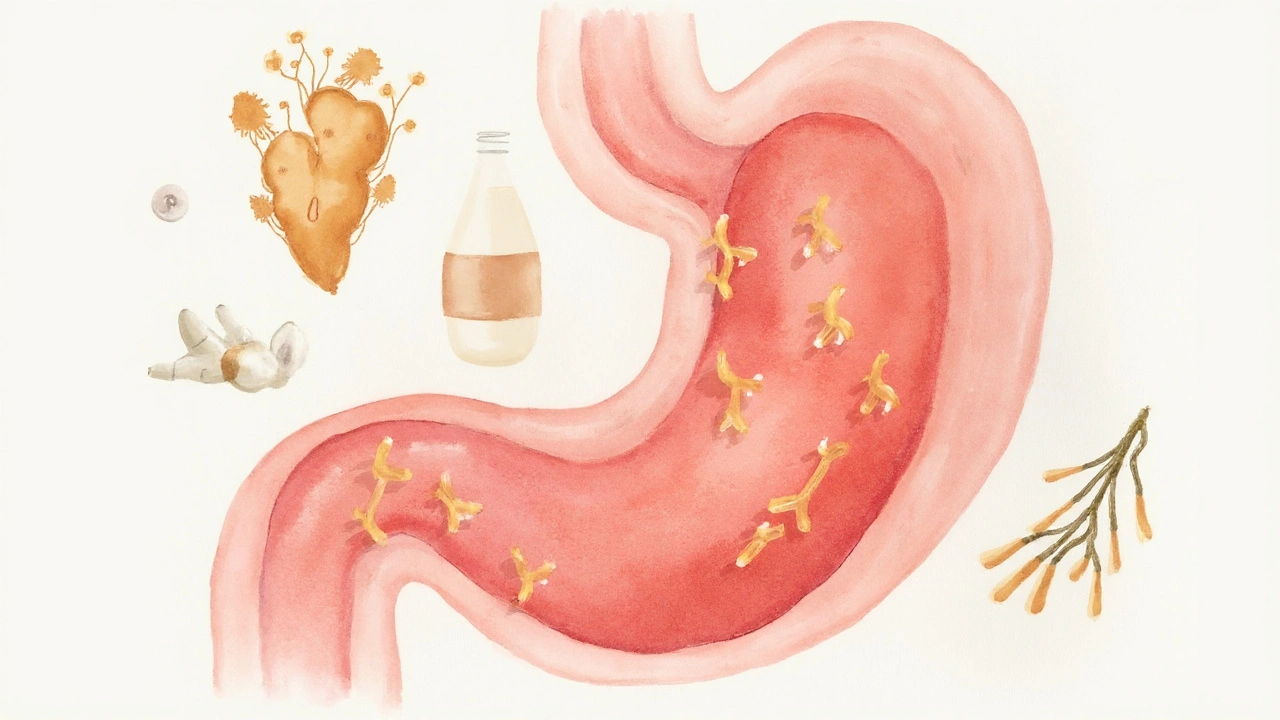Lactose Intolerance is a digestive condition where the small intestine cannot break down lactose, the natural sugar in milk and dairy products. When lactase, the enzyme needed to split lactose, is insufficient, undigested sugar ferments, producing gas and pain. This explains why many people link a sudden stomach ache after a cheese platter or a latte.
Understanding the Core Players
Besides lactose intolerance itself, a handful of related entities shape the experience:
- Lactase enzyme is a protein produced by the brush‑border cells of the small intestine that hydrolyses lactose into glucose and galactose.
- Hydrogen breath test is a non‑invasive diagnostic tool that measures hydrogen produced by bacterial fermentation of undigested lactose.
- Lactase supplements are over‑the‑counter pills or drops containing the lactase enzyme to aid lactose digestion on‑the‑go.
- Probiotics refer to live microorganisms, often Lactobacillus or Bifidobacterium strains, that can modulate gut microbiota and improve lactose tolerance.
- Dairy products include milk, cheese, yogurt, butter and ice‑cream, the primary sources of dietary lactose.
- Genetic predisposition is the inherited variation in the LCT gene that determines lactase persistence or decline after childhood.
- Secondary lactose intolerance occurs when an illness-like celiac disease or Crohn’s-damages the small‑intestinal lining, temporarily reducing lactase production.
- Gut microbiota is the community of bacteria residing in the colon that ferments undigested lactose, creating gas, bloating, and cramps.
Typical Symptoms That Mimic a Stomach Ache
People with lactose intolerance often report a cluster of uncomfortable signs within 30 minutes to two hours after consuming dairy:
- Lower‑abdominal cramping or sharp stomach ache
- Excessive gas and bloating
- Diarrhoea or loose stools
- Flatulence with a sour odor (thanks to bacterial fermentation)
- Nausea, sometimes accompanied by a feeling of fullness
These symptoms overlap with irritable bowel syndrome, making self‑diagnosis tricky. The key clue is timing-symptoms flare soon after dairy exposure and subside once the gut clears the lactose.
Root Causes: Why Lactose Becomes a Trouble Maker
The primary driver is primary lactase deficiency, which follows a natural decline after weaning in most of the world’s population. However, three additional factors often play a role:
- Genetic predisposition: Populations with a history of pastoralism (Northern Europe, some African groups) retain higher lactase activity, while many Asian, African, and Indigenous American groups show a rapid drop.
- Secondary intolerance: Gastrointestinal infections, inflammatory bowel disease, or surgeries that shave off sections of the small intestine can damage lactase‑producing cells.
- Gut microbiota shifts: Antibiotic courses or high‑sugar diets may favour gas‑producing bacteria, intensifying the uncomfortable fermentation.
Understanding which cause applies to you guides the choice of remedy.
How Doctors Confirm Lactose Intolerance
While a symptom diary can be persuasive, clinicians rely on objective tests:
- Hydrogen breath test measures the rise in exhaled hydrogen after a lactose load; an increase of >20 ppm usually signals intolerance.
- Blood glucose test: a modest rise (<20mg/dL) after lactose ingestion suggests poor absorption.
- Elimination diet: 2‑week removal of dairy, followed by gradual re‑introduction, tracks symptom recurrence.
These methods rule out milk protein allergy, which can present with skin rashes or respiratory issues-not just stomach pain.

Everyday Strategies to Tame the Ache
Once you know lactose is the culprit, you have three practical pathways:
- Adjust your diet: Choose low‑lactose or lactose‑free versions of milk, cheese, and yoghurt. Fermented products like kefir often contain less lactose because bacteria pre‑digest it.
- Use enzyme aids: Lactase supplements taken just before dairy can dramatically cut down gas production.
- Support your gut: Probiotic strains such as Lactobacillus acidophilus and Bifidobacterium longum have shown modest improvements in tolerance after several weeks of regular use.
Below is a side‑by‑side look at the three most common remedies.
| Remedy | Onset of Relief | Typical Cost (NZ$ per month) | Pros | Cons |
|---|---|---|---|---|
| Lactase supplements | Immediate (takes effect within minutes) | 10‑20 | Portable, works with any dairy | Must be timed correctly; effectiveness varies with dose |
| Probiotic daily | 2‑4 weeks | 25‑40 | Improves overall gut health, may reduce other GI issues | Slower results; strain‑specific benefits |
| Lactose‑free diet | Immediate (no lactose consumed) | 0‑15 (depends on alternative foods) | Eliminates symptoms completely | Requires label‑reading; may limit calcium sources |
Practical Tips for Everyday Life in Dunedin and Beyond
- Read labels: words like "milk‑derived", "whey", "casein" indicate hidden lactose.
- Swap milk for fortified soy, oat, or almond alternatives; they provide comparable calcium and vitamin D.
- Enjoy hard cheeses (cheddar, parmesan) in moderation-aging reduces lactose to trace amounts.
- Try lactose‑free yogurts that contain live cultures; they aid digestion and keep your gut happy.
- Keep a food‑symptom journal; note timing, portion size, and severity. Patterns will emerge faster than guesses.
When to Seek Professional Help
If you notice any of the following, book an appointment:
- Weight loss or persistent diarrhoea despite dietary changes.
- Severe abdominal pain that wakes you at night.
- Signs of malabsorption such as pale stools, fatigue, or iron deficiency.
- Unclear diagnosis-sometimes milk allergy or celiac disease masquerades as lactose intolerance.
A gastroenterologist can order the hydrogen breath test, assess secondary causes, and tailor a management plan.
Related Topics Worth Exploring
If you found this guide helpful, you might also be curious about:
- Milk protein allergy - an immune‑mediated reaction that can cause hives, wheezing, or anaphylaxis.
- Fructose malabsorption - another sugar‑processing disorder that produces similar bloating.
- Calcium‑rich non‑dairy foods - leafy greens, fortified tofu, and canned fish with bones.
- Gut‑health apps - digital tools for tracking meals, symptoms, and probiotic regimens.

Frequently Asked Questions
Can I develop lactose intolerance as an adult?
Yes. Primary lactase activity usually declines after age5‑6, but many adults remain symptom‑free. Secondary lactose intolerance can appear later if you experience intestinal injury from infection, celiac disease, or inflammatory bowel disease.
How much lactose can a typical intolerant person handle?
Tolerance varies widely. Some people manage 12‑15g (about a cup of milk) without trouble, while others react to as little as 3g. The best approach is to start with a tiny portion and increase only if you stay comfortable.
Do fermented dairy foods like yogurt still cause pain?
Often they don’t. Live cultures in yogurt and kefir pre‑digest lactose, reducing the amount that reaches the colon. However, the benefit depends on the strain mix and how long the product has been fermented.
Are lactase pills safe for daily use?
Generally, yes. They contain an enzyme that simply aids digestion and are not absorbed into the bloodstream. Over‑use isn’t harmful, but relying on them every meal can mask underlying dietary deficiencies, so a balanced approach is recommended.
Can probiotics cure lactose intolerance?
Probiotics can improve tolerance for many, especially strains that produce lactase themselves. Results are modest and take weeks, so they’re best viewed as a supportive strategy rather than a cure‑all.
Is lactose intolerance linked to other health issues?
Indirectly, yes. Chronic gut irritation may affect nutrient absorption, leading to calcium or vitaminD shortfalls. People with secondary intolerance should also screen for the underlying condition, such as celiac disease.


18 Comments
Lauren Ulm
Ever wonder why the dairy lobby pushes milk so hard? 🤔 They don’t want you to know that most of us are genetically wired to lose lactase after childhood. The “one size fits all” advice is a cover‑up for profit, not science. If you’re constantly bloated, maybe the industry is secretly feeding us hidden sugars to keep us hooked. 🌐💥
Michael Mendelson
Honestly, the whole "lactose intolerance" hype is just a fad for the milk‑militarists. People are too lazy to read the peer‑reviewed studies, so they blame their stomach on dairy. If you actually cared about your health you'd stop drinking that antibiotic‑laden milk and think critically.
Ibrahim Lawan
Friends, the journey to understanding lactose intolerance starts with patience and observation. Track every dairy encounter in a simple notebook, noting the time, amount, and symptoms. Over a week you’ll see a clear pattern emerging, like a story that repeats itself. Remember that the small intestine’s brush‑border cells are the unsung heroes producing lactase; when they falter, the sugar remains undigested. This undigested lactose becomes a feast for colonic bacteria, resulting in gas, cramps, and the dreaded diarrhea. If you notice these signs within 30‑90 minutes after a cheese plate, it’s a strong clue. Genetic predisposition plays a major role, especially in populations without a history of pastoralism. However, secondary causes such as a recent bout of gastroenteritis can temporarily shut down lactase production. In such cases, the hydrogen breath test is a reliable diagnostic tool-look for a rise above 20 ppm. While awaiting test results, consider lactase enzyme supplements; they act like a temporary bridge, breaking down lactose before it reaches the colon. Probiotic strains like Lactobacillus acidophilus may also help rebalance your gut microbiota over time. Finally, be kind to yourself; dietary adjustments are a form of self‑care, not punishment. Celebrate the small victories-whether it’s enjoying a lactose‑free yogurt or a dairy‑free pizza-and remember that many thrive on alternative calcium sources such as leafy greens or fortified plant milks. Stay curious, stay empowered, and let your body teach you what works best.
Just Sarah
In reference to the aforementioned article, one must consider the temporal relation between lactose ingestion and the onset of abdominal discomfort; typically, symptoms manifest within a half‑hour to two hours post‑consumption. Moreover, the differential diagnosis should include irritable bowel syndrome, given the overlapping clinical presentation. It is prudent to employ objective measures, such as the hydrogen breath test, to substantiate the diagnosis.
Anthony Cannon
Lactose intolerance prevalence varies worldwide; Northern Europeans often retain lactase, while many Asian populations do not. Probiotics can aid some individuals but are not a cure‑all. If you experience consistent symptoms, consider testing before self‑diagnosing.
Kristie Barnes
Totally get what you said about testing first-I've tried the breath test and it really cleared things up for me. I now just keep a small bottle of lactase tablets in my bag, and it makes coffee runs so much easier.
Zen Avendaño
That's solid advice. I also added a fermented kefir habit; the probiotics seem to mellow the occasional bloating. It’s all about finding that personal routine.
Michelle Guatato
Wake up, people! The real secret is that dairy farms are adding hidden enzymes to mask lactose levels, so you never know what you’re actually consuming. The government’s silence is part of a larger agenda to keep us dependent on cow products.
Gabrielle Vézina
Anyway it’s not that big a deal. People overreact to a little gas.
carl wadsworth
While I respect the contrarian view, it’s important to rely on peer‑reviewed literature. The hidden‑enzyme claim lacks credible evidence and distracts from practical management strategies.
Neeraj Agarwal
The grammar in that post is off, but the science is correct. Lactase deficiency is real.
Rose K. Young
Yup, it’s just another excuse for people to avoid dairy. If you can’t handle a glass of milk, maybe you’re just weak.
Christy Pogue
Hey folks, I’ve been there-steady stomach aches after a latte can kill the vibe. My go‑to now? Lactase drops before coffee and a splash of oat milk. It’s a game‑changer!
Helena Pearson
🌟 Absolutely love the lactase drops tip! 🌟 I also experiment with almond milk foam for my espresso-no gas, pure joy. 😄 Keep sharing those hacks; we’re all in this gut‑health quest together!
Patricia Fallbeck
Oh please, swapping milk for almond foam is just a trendy fad. If you can’t digest basic dairy, maybe you should reconsider your entire diet rather than chase after gimmicks.
Brett Snyder
We need to protect our heritage foods! Dairy is part of our national identity, and these “lactase drops” are just foreign interference.
Nidhi Jaiswal
Yes, dairy is important but health comes first. Try lactose free options and see how you feel.
Sunil Sharma
Adding a spoonful of Greek yogurt to smoothies can give you that creamy texture without the lactose spike. Just make sure it’s a live‑culture variety.